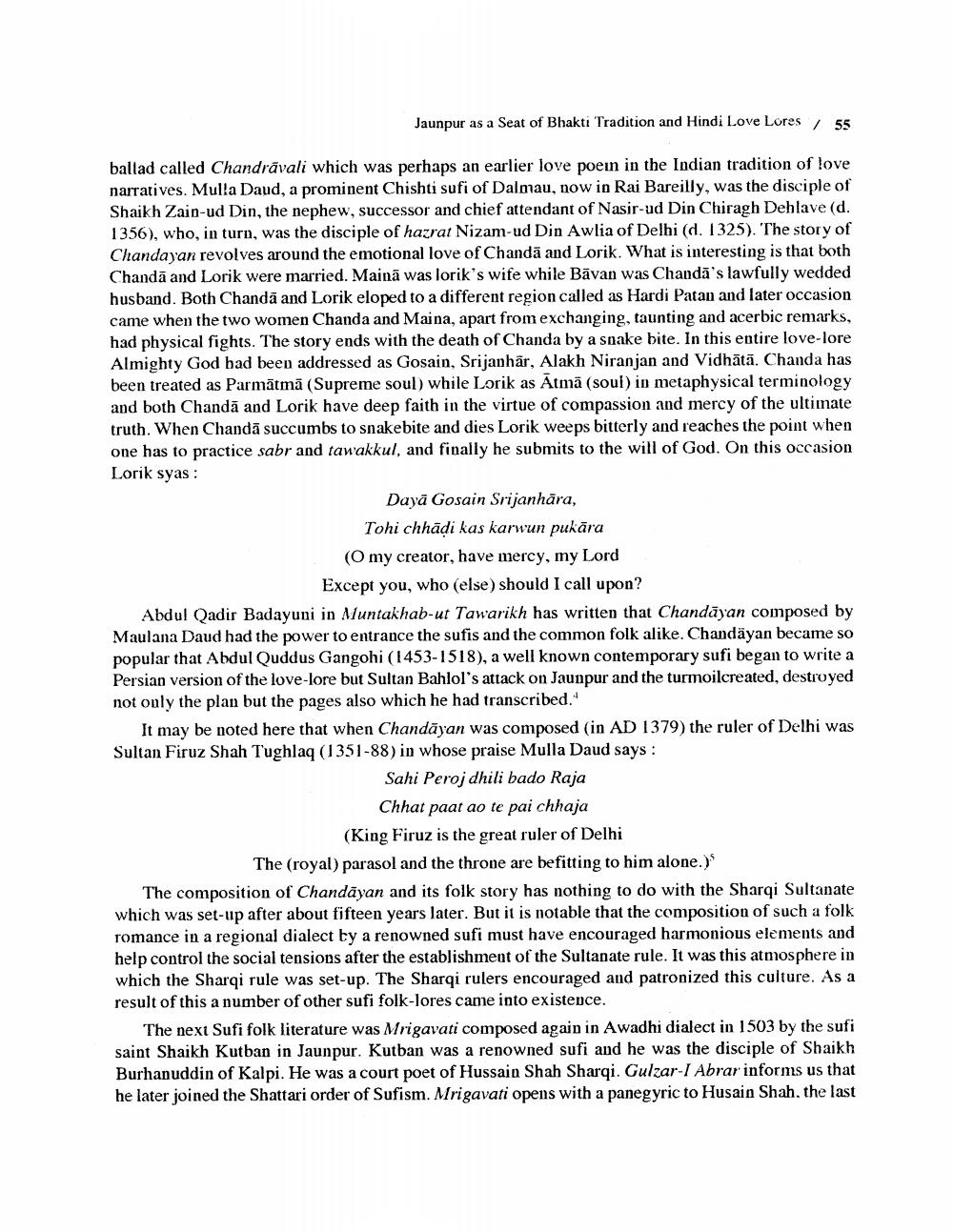________________
Jaunpur as a Seat of Bhakti Tradition and Hindi Love Lores / 55
ballad called Chandrāvali which was perhaps an earlier love poein in the Indian tradition of love narratives. Mulla Daud, a prominent Chishti sufi of Dalmau, now in Rai Bareilly, was the disciple of Shaikh Zain-ud Din, the nephew, successor and chief attendant of Nasir-ud Din Chiragh Dehlave (d. 1356), who, in turn, was the disciple of hazrat Nizam-ud Din Awlia of Delhi (d. 1325). The story of Chandayan revolves around the emotional love of Chandā and Lorik. What is interesting is that both Chandā and Lorik were married. Mainā was lorik's wife while Bāvan was Chanda's lawfully wedded husband. Both Chanda and Lorik eloped to a different region called as Hardi Patan and later occasion came when the two women Chanda and Maina, apart from exchanging, taunting and acerbic remarks, had physical fights. The story ends with the death of Chanda by a snake bite. In this entire love-lore Almighty God bad been addressed as Gosain, Srijanhar, Alakh Niranjan and Vidhātā. Chanda has been treated as Parmātmā (Supreme soul) while Lorik as Atmā (soul) in metaphysical terminology and both Chanda and Lorik have deep faith in the virtue of compassion and mercy of the ultimate truth. When Chandā succumbs to snakebite and dies Lorik weeps bitterly and reaches the point when one has to practice sabr and tawakkul, and finally he submits to the will of God. On this occasion Lorik syas :
Dayā Gosain Srijanhāra, Tohi chhādi kas karwun pukāra (O my creator, have mercy, my Lord
Except you, who (else) should I call upon? Abdul Qadir Badayuni in Muntakhab-ut Tawarikh has written that Chandāyan composed by Maulana Daud had the power to entrance the sufis and the common folk alike. Chandayan became so popular that Abdul Quddus Gangohi (1453-1518), a well known contemporary sufi began to write a Persian version of the love-lore but Sultan Bahlol's attack on Jaunpur and the turmoilcreated, destroyed not only the plan but the pages also which he had transcribed."
It may be noted here that when Chandāyan was composed (in AD 1379) the ruler of Delhi was Sultan Firuz Shah Tughlaq (1351-88) in whose praise Mulla Daud says:
Sahi Peroj dhili bado Raja
Chhat paat ao te pai chhaja
(King Firuz is the great ruler of Delhi
The (royal) parasol and the throne are befitting to him alone.) The composition of Chandayan and its folk story has nothing to do with the Sharqi Sultanate which was set-up after about fifteen years later. But it is notable that the composition of such a folk romance in a regional dialect ty a renowned sufi must have encouraged harmonious elements and help control the social tensions after the establishment of the Sultanate rule. It was this atmosphere in which the Sharqi rule was set-up. The Sharqi rulers encouraged and patronized this culture. As a result of this a number of other sufi folk-lores came into existence.
The next Sufi folk literature was Mrigavati composed again in Awadhi dialect in 1503 by the sufi saint Shaikh Kutban in Jaunpur. Kutban was a renowned sufi and he was the disciple of Shaikh Burhanuddin of Kalpi. He was a court poet of Hussain Shah Sharqi. Gulzar-I Abrar informs us that he later joined the Shattari order of Sufism. Mrigavati opens with a panegyric to Husain Shah, the last




